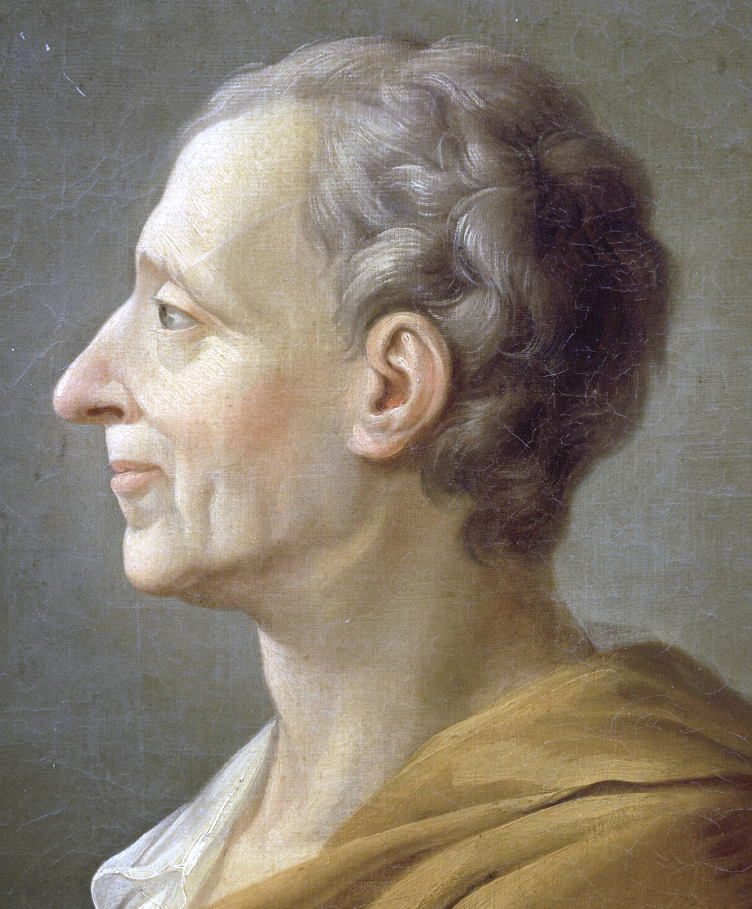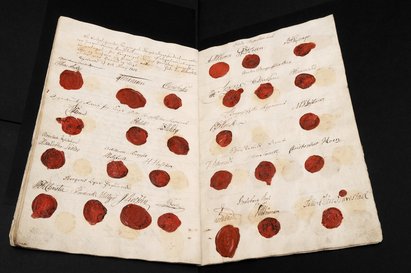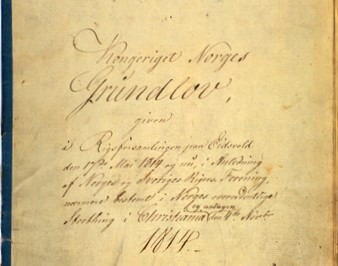Writing the Norwegian constitution, 1814
In 1814, Denmark lost the territory of Norway in the aftermath of the Napoleonic wars, and this provided a window for the Norwegian constitution to be established. It was founded on the principles of popular sovereignty, participatory democracy and individual rights. It is the second oldest constitution in the world and remains a cornerstone of Norwegian law, despite several amendments.
The 1814 Norwegian constitution was modern for its time. It was based on a few key principles: popular sovereignty, defined rights for participatory democracy, and independent rights of the individual. The ideas upon which the constitution of 17th May 1814 were built were internationally well known and were also to be found in other constitutions from around 1800, such as the constitution of the United States and the French constitution from 1791. The idea of popular sovereignty meant that the people themselves constituted the state, not the king, which was of course the case with an absolute monarchy. The right to create a political entity of the state would thus always belong to the people.
That said, the people could choose to let either a prince or king exercise the power of the state. In this case, the people would enter into a covenant with the regent and were thus committed to comply with it. The head of state, however, did not have the right to transfer power to others without asking the people.

PICTURE: Portrait of the Danish heir presumptive and governor of Norway, Christian Frederik, in 1814. Original by F. C. Grøger. Photo: Stortinget [The Storting]. CC BY-ND 2.0.
The restricted power of a prince
If the regent broke the covenant, sovereignty returned to the people, who could then pass the power on to another regent or change the form of government. This approach was based on both the English Revolution of 1688 and on the American Declaration of Independence in 1776. Thoughts along these same lines influenced Christian Frederik's Norwegian advisers in February 1814 when they maintained that he no longer had any more right to declare himself King of Norway than any other Norwegian. The right to decide on who should govern had been given to the Norwegian people after the King of Denmark at that time, Frederick VI, repealed Norway's oath to the Danish kingdom in the Treaty of Kiel. The first paragraph of the constitution of 17th May 1814 specified the following principle: Norway was an "independent" and "inalienable" kingdom. Thus, the concept of popular sovereignty became a crucial element in Norway's history - not the sovereignty of a regent or his dynasty.

PICTURE: Portrait Charles-Louis de Secondat, Baron de la Brède et de Montesquieu, known as Montesquieu (1689-1755), who is considered the creator of the principle of separation of powers and stated that political power should be divided between three institutions - a legislative, an executive and a judiciary. Photo: unknown artist, public domain.
The people’s right to participate in decision-making
The constitution was also based on the separation of powers. Although this was not explicitly stated in the text, the sections distinguish between legislative, executive and judicial power. The power of the monarch was thus restricted due to the other branches of power. Legislative power was given to the representatives of the Storting, the Norwegian parliament. Through the electoral system, the people participated in decisions concerning their own welfare. In connection with this, the Storting was to decide the state budget.
In no way did the division of powers or the electoral system equate to the full control of the state, however. The executive power continued to belong to the king, who was given full authority to choose a government, to command the military, to decide on foreign policy and when to go to war or not.
The Storting and the executive power of the regent
The constitution also gave other considerable rights to the executive branch of power: Legislative decisions in the Storting could be met with a regent's veto up to three times, and even though the courts were to judge wholly independently, the king also had the right to pardon people. Between the parliamentary periods - which lasted three years - the king and the government were quite free to act as they chose. The constitution also made the king immune to prosecution. The ministers could, however, be controlled by the Storting's only effective means: the constitutional court. It consisted of lay people and members of the Supreme Court and for the first 20 years of the constitution being in existence, the Storting used the constitutional court against several ministers.
Overall, the Storting was endowed with considerably more power than parliaments in many other countries that had a constitution from around the same time. This was largely due to the fact that power was used effectively by the representatives from the very beginning.

PICTURE: The Norwegian constitution was dated, sealed and signed on 17th May 1814. Owner: The Storting Archive. Photo: Stortinget / Vidar M. Husby. CC BY-ND 2.0
Limited human rights
The Norwegian constitution also gave rights to every individual in a way that was independent from both the different bodies of power and the individual’s status. Among the most important rights were the right to be sentenced by law, to dispose of one’s own property, and freedom of the press - which quite rightly had important reservations. The general freedom of belief and religion, however, was not included in the constitution, which prohibited groups defined by their religion such as Jews, Jesuits and monastic orders. Individual rights were more limited, however, than in the constitution of the United States, for example. The reasons were many, but it may partly have been to consolidate the existing social structure and its balance of power.
On the one hand, those who wrote the constitution were very conscious of the principles of the right of the individual and co-determination. On the other hand, they probably feared that disorder would occur if the population was allowed too much personal freedom.
Further reading:
- Eli Fure, Eidsvoll 1814: hvordan Grunnloven ble til [Eidsvoll 1814: how the Constitution was created], (Oslo, 1989).
- Ola Mestad, ed., Frihetens forskole: professor Schlegel og eidsvollsmennenes læretid i København, bind 1 av Nye perspektiver på Grunnloven 1814–2014 [The precursor to freedsom: Professor Schlegel and the Eidsvoll men's apprenticeship in Copenhagen, volume 1 of New perspectives on the Constitution 1814–2014], (Oslo, 2013).
Thanks go to norgeshistorie.no for allowing us to translate this article. The original article can be read in Norwegian here. It was translated into English by the nordics.info team.

